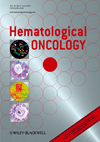Novel agents-based regimens as induction treatment prior to autologous stem-cell transplantation in newly diagnosed multiple myeloma: a meta-analysis of randomized controlled trials
Abstract
To investigate the effect of novel agents like bortezomib, lenalidomide and thalidomide as part of induction treatment prior to autologous stem-cell transplantation (ASCT) for previously untreated patients with multiple myeloma, we performed a meta-analysis of randomized controlled trials (RCTs). Medline, Embase, the Cochrane controlled trials register and the Science Citation Index were searched for RCTs of novel agents as part of induction therapy before ASCT. Three RCTs of bortezomib, two RCTs of thalidomide and no RCT of lenalidomide were identified, covering a total of 2,316 subjects. Due to different mechanisms of action, we performed a subgroup analysis by type of agent (thalidomide or bortezomib). The weighted risk ratios of a complete response (CR) were 4.25 [95% CI: 2.44–7.41] (p < 0.001) for bortezomib and 1.66 [95% CI: 1.15–2.38] (p = 0.007) for thalidomide, respectively. The summary hazard ratios for progression-free survival (PFS) were 0.73 [95% CI: 0.59–0.89] (p = 0.002) for bortezomib and 0.68 [95% CI: 0.59–0.79] (p < 0.001) for thalidomide, respectively. The corresponding ratios for overall survival (OS) were 0.87 [95% CI: 0.64–1.18] (p = 0.37) and 0.88 [95% CI: 0.73–1.05] (p = 0.14), respectively. Additionally, there was a statistically significant heterogeneity between subgroups (thalidomide and bortezomib) for CR (p = 0.005) but nonsignificant for PFS (p = 0.64) and OS (p = 0.97). In conclusion, our analysis showed novel agents as induction treatment prior to ASCT improved CR and PFS but not OS. Copyright © 2011 John Wiley & Sons, Ltd.




